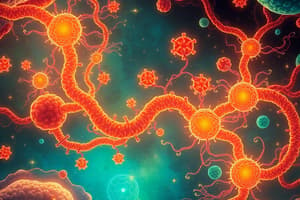Podcast
Questions and Answers
Glycolysis inputs include: Glucose, 2 ATP, 2 NAD+, ___.
Glycolysis inputs include: Glucose, 2 ATP, 2 NAD+, ___.
4 ADP + P
Glycolysis outputs include: 2 pyruvates, ___, 2 NADH + H+, 2 H2O.
Glycolysis outputs include: 2 pyruvates, ___, 2 NADH + H+, 2 H2O.
4 ATP
Where does glycolysis occur?
Where does glycolysis occur?
cytoplasm
Citric Acid Cycle inputs include: 2 acetyl CoA, 2 oxaloacetate, ___.
Citric Acid Cycle inputs include: 2 acetyl CoA, 2 oxaloacetate, ___.
Citric Acid Cycle outputs include: 4 CO2, ___, 6 NADH + H+, 2 FADH2.
Citric Acid Cycle outputs include: 4 CO2, ___, 6 NADH + H+, 2 FADH2.
Where does the citric acid cycle occur?
Where does the citric acid cycle occur?
Electron Transport Chain (ETC) inputs include: 10 NADH + H+, ___.
Electron Transport Chain (ETC) inputs include: 10 NADH + H+, ___.
Electron Transport Chain (ETC) outputs include: 10 NAD+, 2 FAD, ___, 34 ATP.
Electron Transport Chain (ETC) outputs include: 10 NAD+, 2 FAD, ___, 34 ATP.
Fermentation inputs include: glucose, ___.
Fermentation inputs include: glucose, ___.
Fermentation outputs include: 2 lactate or 2 alcohol, 2 CO2, ___.
Fermentation outputs include: 2 lactate or 2 alcohol, 2 CO2, ___.
What is an anabolic process?
What is an anabolic process?
What is a catabolic process?
What is a catabolic process?
What is fermentation?
What is fermentation?
Endergonic reactions release energy.
Endergonic reactions release energy.
Exergonic reactions release energy.
Exergonic reactions release energy.
What is a coupled reaction?
What is a coupled reaction?
Why is NAD important?
Why is NAD important?
What does reduced mean?
What does reduced mean?
What does oxidized mean?
What does oxidized mean?
What is oxidative phosphorylation?
What is oxidative phosphorylation?
Inputs/Outputs of Glycolysis: Input to glycolysis: Glucose + 2 ATP, 2 NAD+, ___; Output of glycolysis: 2 pyruvate, ___, NADPH, 2 H2O.
Inputs/Outputs of Glycolysis: Input to glycolysis: Glucose + 2 ATP, 2 NAD+, ___; Output of glycolysis: 2 pyruvate, ___, NADPH, 2 H2O.
Inputs/Outputs of Pyruvate: Input to pyruvate oxidation: 2 Pyruvate, 2 CoA, 2 NAD+; Output of pyruvate oxidation: ___, 2 CO2, 2 NADH.
Inputs/Outputs of Pyruvate: Input to pyruvate oxidation: 2 Pyruvate, 2 CoA, 2 NAD+; Output of pyruvate oxidation: ___, 2 CO2, 2 NADH.
Input/Outputs of the Krebs Cycle: Input to Citric Acid Cycle (Krebs Cycle): 2 Acetyl CoA, 2 Oxaloacetate, 2 ADP + Pi, 6 NAD+, 2 FAD; Output of Citric Acid Cycle: 2 CoA, 4 CO2, ___, 6 NADH, 2 FADH2.
Input/Outputs of the Krebs Cycle: Input to Citric Acid Cycle (Krebs Cycle): 2 Acetyl CoA, 2 Oxaloacetate, 2 ADP + Pi, 6 NAD+, 2 FAD; Output of Citric Acid Cycle: 2 CoA, 4 CO2, ___, 6 NADH, 2 FADH2.
Input/Output of Electron Transport Chain (ETC): Input to Electron Transport Chain: 10 NADH, 2 FADH2, 6 O2, 34 ADP + Pi; Output of Electron Transport Chain: 10 NAD+, 2 FAD, H2O, ___.
Input/Output of Electron Transport Chain (ETC): Input to Electron Transport Chain: 10 NADH, 2 FADH2, 6 O2, 34 ADP + Pi; Output of Electron Transport Chain: 10 NAD+, 2 FAD, H2O, ___.
Input/Output of Fermentation: Input to fermentation: 2 pyruvate, 2 NADH; Output of fermentation: ___, 2 NAD+, 2 ethanol and 2 CO2 or lactate.
Input/Output of Fermentation: Input to fermentation: 2 pyruvate, 2 NADH; Output of fermentation: ___, 2 NAD+, 2 ethanol and 2 CO2 or lactate.
Where does glycolysis occur and what are the energy carriers?
Where does glycolysis occur and what are the energy carriers?
Where does the Krebs cycle occur and what are the energy carriers?
Where does the Krebs cycle occur and what are the energy carriers?
Where does the Electron Transport Chain occur and what are the energy carriers?
Where does the Electron Transport Chain occur and what are the energy carriers?
Flashcards are hidden until you start studying
Study Notes
Glycolysis
- Inputs: Glucose, 2 ATP, 2 NAD+, 4 ADP + P
- Outputs: 2 pyruvates, 4 ATP, 2 NADH + H+, 2 H2O
- Location: Cytoplasm
Citric Acid Cycle (Krebs Cycle)
- Inputs: 2 Acetyl CoA, 2 Oxaloacetate, 2 ADP + P, 6 NAD+, 2 FAD
- Outputs: 4 CO2, 2 ATP, 6 NADH + H+, 2 FADH2
- Location: Mitochondrial matrix
Electron Transport Chain (ETC)
- Inputs: 10 NADH + H+, 2 FADH2
- Outputs: 10 NAD+, 2 FAD, H2O, 34 ATP
Fermentation
- Inputs: Glucose, 2 ATP
- Outputs: 2 lactate or 2 alcohol, 2 CO2, 4 ATP
- Occurs in the absence of oxygen (anaerobic process)
Metabolic Processes
- Anabolic: Builds large molecules from small molecules
- Catabolic: Breaks down large molecules for energy
Energy Reactions
- Endergonic: Absorbs energy
- Exergonic: Releases energy
- Coupled reaction: One exergonic reaction provides energy for an endergonic reaction, e.g., ATP formation
Importance of NAD
- Promotes cellular functions for energy creation, key in mitochondrial function
- Transports electrons during cellular respiration; reduced to NADH, which carries electrons to the ETC
Oxidation and Reduction
- Reduced: Electrons added to an atom or ion (removal of oxygen or addition of hydrogen)
- Oxidized: Electrons combined with oxygen.
Oxidative Phosphorylation
- Metabolic pathway where enzymes oxidize nutrients, releasing energy to produce ATP
- Occurs in mitochondria, essential for cellular respiration
Summary of Inputs/Outputs
- Glycolysis: Input - Glucose + 2 ATP; Output - 2 pyruvate, 4 ATP, NADPH, 2 H2O
- Pyruvate Oxidation: Input - 2 Pyruvate; Output - 2 Acetyl CoA, 2 CO2, 2 NADH
- Krebs Cycle: Input - 2 Acetyl CoA, 2 Oxaloacetate; Output - 4 CO2, 2 ATP, 6 NADH, 2 FADH2
- ETC: Input - 10 NADH, 2 FADH2; Output - 10 NAD+, 2 FAD, H2O, 34 ATP
- Fermentation: Input - 2 pyruvate; Output - 2 ATP, 2 NAD+, 2 ethanol or Lactate, 2 CO2
Review of Processes
- Glycolysis: Occurs in cytoplasm, splits glucose into pyruvates, produces 2 ATP and NADH.
- Krebs Cycle: Takes place in the mitochondrial matrix, removes energy from citric acid, produces ATP, NADH, and FADH2, generates CO2.
- ETC: Series of proteins in the mitochondria generate the majority of ATP produced in cellular respiration (34 ATP).
Studying That Suits You
Use AI to generate personalized quizzes and flashcards to suit your learning preferences.





